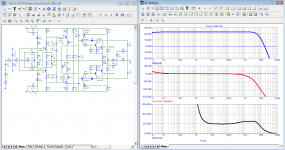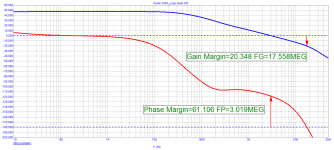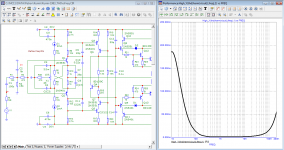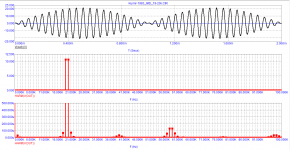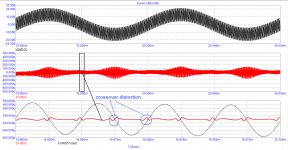Everybody has different ears, different neuron cell interconnections, different mindset, different upbringing and different attitude. Live and let Live, how else?
Or are of the opposite sex which can be a wake up call if asked for an opinion.
For comparison, similar parameters of the Kumir-001 amplifier of the same year (1983) of development and production of the Soviet Union.
It is felt that the developers not only knew the NFB theory, but also understood how it works.
This vintage amplifier still pleases the ear of many radio amateurs today.
First pole above 20 kHz
Loop gain in phase with the output voltage over most of the audio range.
The signal propagation delay is about 50 ns and remains at this level up to several MHz. Due to the low time propagation delay, crossover distortion is negligible, as are other types of distortion. Due to this, the noise stand in the IMD sound band is also small.
Year of the bull, and FCD is like a red rag for many colleagues on the forum, so I will not show them.
It is felt that the developers not only knew the NFB theory, but also understood how it works.
This vintage amplifier still pleases the ear of many radio amateurs today.
First pole above 20 kHz
Loop gain in phase with the output voltage over most of the audio range.
The signal propagation delay is about 50 ns and remains at this level up to several MHz. Due to the low time propagation delay, crossover distortion is negligible, as are other types of distortion. Due to this, the noise stand in the IMD sound band is also small.
Year of the bull, and FCD is like a red rag for many colleagues on the forum, so I will not show them.
Attachments
I think the semis shown in the simulated designs are what is known as "jelly bean" types - general purpose transistors that likely could be replaced by many similar transistors from many countries - from the former Soviet Union to Europe, the US, Japan, China, whatever, over the past 30-40 years. In my view, the adoption of generic transistor types like these makes schematics easier to follow, discussions flow easier and can be better understood by more readers. That has to be better than wasting words and time on semiconductor quality distractions.
Nice CFA, quite advanced for '83. Anyway the price for having dominant pole relatively high @20kHz is low loop gain at lower frequencies. Same can be achieved with common topologies e.g. by putting adequate resistor from VAS output to ground, no magic there.
GD of closed loop amp is almost entirely function of its phase response. Two amps with identical closed loop phase response (consequently with the same set of poles and nulls) have same GD. Amp internals doesn't matter, only its closed loop Bode plot. Take an opamp and configure it to have same FR as Kumir, you get the same GD.
GD of closed loop amp is almost entirely function of its phase response. Two amps with identical closed loop phase response (consequently with the same set of poles and nulls) have same GD. Amp internals doesn't matter, only its closed loop Bode plot. Take an opamp and configure it to have same FR as Kumir, you get the same GD.
It is a nice CFA, particularly in that it doesn't have a diamond input with its centre fed from constant current sources isolated from the input. This network has the input directly connected to the base from a lower impedance, hence can support improved performance as a non-inverting amplifier. Many years ago the term Transient Intermodulation Distortion ("TIM") was in vogue, resulting in amplifiers being designed with a series string of emitter followers on the output (greater than two) after the Tz node. This has 3.
The design of the amplifier is symmetrical in its use of NPN and PNP devices. This symmetry rejects second harmonic as conditional upon equal gains and frequency response of devices being in symmetrical locations. In other words attention needs to be paid to the characteristics of complementary devices to ensure the rejection of second harmonic as notwithstanding where they come from.
The design of the amplifier is symmetrical in its use of NPN and PNP devices. This symmetry rejects second harmonic as conditional upon equal gains and frequency response of devices being in symmetrical locations. In other words attention needs to be paid to the characteristics of complementary devices to ensure the rejection of second harmonic as notwithstanding where they come from.
How can we be sure?It is a nice CFA, ...
... Loop gain plot for the other amp, much more broadband therefore favored by "petr_2009", however, is in fact an oscillator. It's radically under-compensated by having a unity gain crossover at 4.8MHz, and when the phase turns 180-degree around the loop, the loop gain is at +2dB, shot up by the peaking caused by the 2nd pole...
It's a nice CFA,
You can't be, as "niceness" is vague. It is based on the perceived ability of the design to reject second harmonic as a critical requirement to performance. Its importance is based upon an understanding of the non-linearity as a complete wave shape and its position in relation to the fundamental, that in turn contains a second harmonic in a frequency spectrum resulting from the non-symmetric non-linear transfer function of an amplifier.
How can we be sure?
You can't be, as "niceness" is vague. It is based on the perceived ability of the design to reject second harmonic as a critical requirement to performance. Its importance is based upon an understanding of the non-linearity as a complete wave shape and its position in relation to the fundamental, that in turn contains a second harmonic in a frequency spectrum resulting from the non-symmetric non-linear transfer function of an amplifier.
- Home
- Amplifiers
- Solid State
- First cycle distortion - Graham, what is that?
